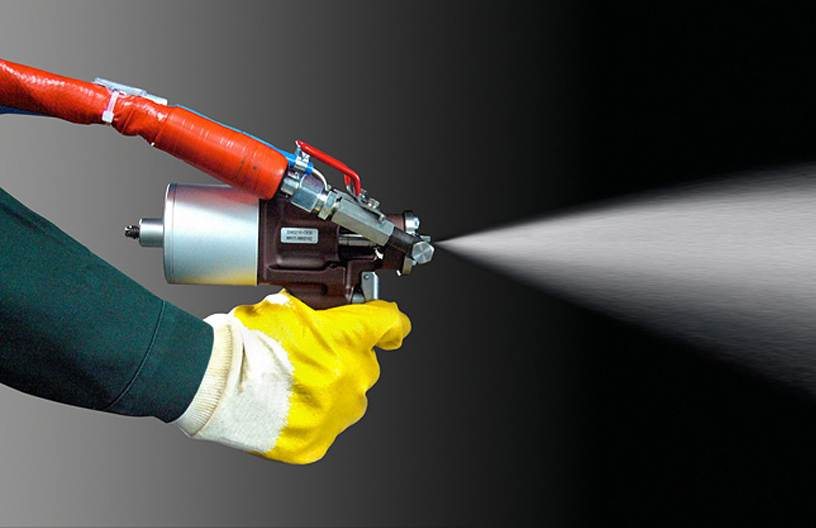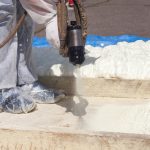High-Viscosity Spray is Used in Multiple Industries Worldwide
Polyurethane is one of the most flexible materials in today’s market, with countless applications relying on it for performance and extensive customization options. One of the most common multi-industry uses is in polyurethane foam spray. Unlike other applications, spray polyurethane is often high in viscosity and high in temperature — requiring specialized equipment to mix and distribute it.
Examples of applications in which polyurethane foam spray is used include the construction industry, which utilizes spray for insulation in structures. This spray insulation is used in roofing, between studs on exterior walls, and even between interior wall studs to assist with soundproofing and structural integrity. Spray equipment ensures that the material is uniformly distributed in these areas, and because they’re typically tight on space, spray equipment is often the only solution available thanks to its mobility.
Insulated foam is used in multiple other applications as well, such as the military, aerospace, automotive, and sporting goods industries where the insulating properties of polyurethane foam reduce noise, provide stability and protection, protect spaces from extreme temperatures, and more. The consumer goods industry also relies on polyurethane foam spray for various coatings that protect items and people from the elements and maintain desirable product appearances.
While there are ample polyurethane spray equipment options available in today’s market, not every piece of equipment is ideal for your application. This is particularly true if you’re involved in the manufacturing of different product types. Here, we’ll explore a few polyurethane spray equipment properties that should be considered to ensure you have the right tools for your needs.
3 Aspects of Ideal Spray Equipment
Flexibility with Different Mix Head Types
While the spray equipment itself is the foundation of your production, the mix heads you use are how that material gets distributed into or onto the end application. If you’re using the spray equipment in a facility but have changing production needs, the ability to swap out different mix heads as needed will be essential for success.
At Linden Polyurethane, our spray equipment works with five standard and multiple custom-designed mix head types. Examples include handheld mix heads for applying the material in smaller spaces (or in mobile/field applications) or low-volume projects, robot-mounted spray mix heads for automated production environments, and even pour mix heads for seamless production needs.
Learn more about our spray equipment here.
Multiple Material Types Can Be Used
While polyurethane spray equipment is often used for polyurethane chemical distribution, it can also be used for elastomers and even polyurea. Because of that, this equipment can find a home in numerous industries and applications. Examples include surface protectant application in manufacturing, waterproofing surfaces and protecting concrete in construction, reinforcing structures in the military, and corrosion protection and tank linings in the chemical industry.
Linden Polyurethane has partnered with Isotherm AG — a leading innovator of polyurethane processing equipment and machinery — to develop the PSM 700 spray machine. This advanced system can be fitted with multiple mix head types, can be used in facilities or in the field, and has strong continuous outputs and various mixing ratios.
Learn more about the Linden-Isotherm PSM 700.
Self-Cleaning and Low Maintenance
With production continuing to increase amid growing demand for products and organizations still catching up from the slowdown in 2020, the focus on equipment reliability and performance has never been greater. The last thing companies need is to be dealing with outdated, malfunctioning, or underperforming polyurethane foam spray equipment. What’s needed are self-cleaning and maintenance-free solutions to ensure maximum uptime and continuous production.
At Linden Polyurethane, our spray equipment is built to withstand the most rigorous production environments and demands, requiring little-to-no maintenance throughout the entirety of its lifespan. Our high-performing mix heads are also mechanically self-cleaning and frequently outperform the competition and even our own shot count ratings. Should repair be needed, we offer our Zip-It & Ship-It rapid mix head repair program, with next-day service available (we even service many of our competitors’ mix heads and pumps).
Learn more about our repair services and other support options.
Work with the Polyurethane Foam Spray Experts
Since we were founded in 1985, Linden Polyurethane has been designing, engineering, and supporting a full portfolio of polyurethane spray equipment, mix heads, bulk storage and blending solutions, metering equipment, and more. We are proud to have innovated various solutions that have helped companies worldwide become more efficient, produce better products, and get the most value possible out of their investment in our equipment. We can help you do the same.
Whether you’re looking for a solution to distribute material in the field or want to streamline your production with more reliable equipment, Linden Polyurethane offers the customization and support you need to achieve your goals. Our team will work with you to understand your objectives and develop a customized spray solution that maximizes productivity, reduces waste, improves material performance, and more.





